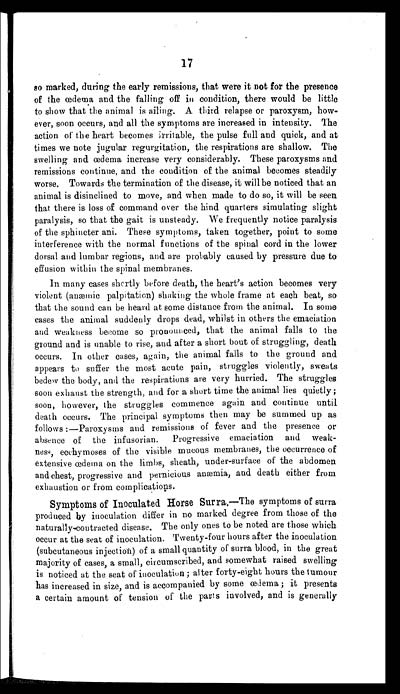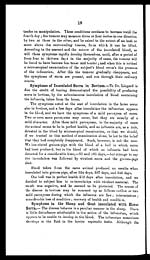Medicine - Veterinary > Civil Veterinary Departments > Civil Veterinary Department ledger series I-VI > Volume IV - Horse surra
(423) Page 17
Download files
Individual page:
Thumbnail gallery: Grid view | List view

17
so marked, during the early remissions, that were it not for the presence
of the œdema and the falling off in condition, there would be little
to show that the animal is ailing. A third relapse or paroxysm, how-
ever, soon occurs, and all the symptoms are increased in intensity. The
action of the heart becomes irritable, the pulse full and quick, and at
times we note jugular regurgitation, the respirations are shallow. The
swelling and œdema increase very considerably. These paroxysms and
remissions continue, and the condition of the animal becomes steadily
worse. Towards the termination of the disease, it will be noticed that an
animal is disinclined to move, and when made to do so, it will be seen
that there is loss of command over the hind quarters simulating slight
paralysis, so that the gait is unsteady. We frequently notice paralysis
of the sphincter ani. These symptoms, taken together, point to some
interference with the normal functions of the spinal cord in the lower
dorsal and lumbar regions, and are probably caused by pressure due to
effusion within the spinal membranes.
In many cases shortly before death, the heart's action becomes very
violent (anæmic palpitation) shaking the whole frame at each beat, so
that the sound can be heard at some distance from the animal. In some
cases the animal suddenly drops dead, whilst in others the emaciation
and weakness become so pronounced, that the animal falls to the
ground and is unable to rise, and after a short bout of struggling, death
occurs. In other cases, again, the animal falls to the ground and
appears to suffer the most acute pain, struggles violently, sweats
bedew the body, and the respirations are very hurried. The struggles
soon exhaust the strength, and for a short time the animal lies quietly;
soon, however, the struggles commence again and continue until
death occurs. The principal symptoms then may be summed up as
follows:—Paroxysms and remissions of fever and the presence or
absence of the infusorian. Progressive emaciation and weak-
ness, ecchymoses of the visible mucous membranes, the occurrence of
extensive œdema on the limbs, sheath, under-surface of the abdomen
and chest, progressive and pernicious auæmia, and death either from
exhaustion or from complications.
Symptoms of Inoculated Horse Surra.—The symptoms of surra
produced by inoculation differ in no marked degree from those of the
naturally-contracted disease. The only ones to be noted are those which
occur at the seat of inoculation. Twenty-four hours after the inoculation
(subcutaneous injection) of a small quantity of surra blood, in the great
majority of cases, a small, circumscribed, and somewhat raised swelling
is noticed at the seat of inoculation; alter forty-eight hours the tumour
has increased in size, and is accompanied by some œdema; it presents
a certain amount of tension of the parts involved, and is generally
Set display mode to: Large image | Zoom image | Transcription
Images and transcriptions on this page, including medium image downloads, may be used under the Creative Commons Attribution 4.0 International Licence unless otherwise stated. ![]()
| India Papers > Medicine - Veterinary > Civil Veterinary Departments > Civil Veterinary Department ledger series I-VI > Horse surra > (423) Page 17 |
|---|
| Permanent URL | https://digital.nls.uk/75517159 |
|---|




